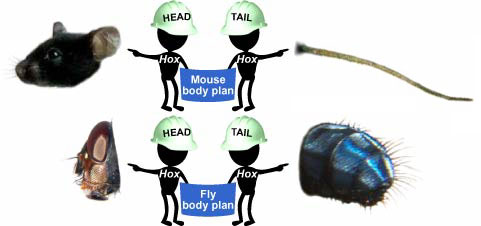“General purpose” control genes are important elements in building complicated organisms like flies. Some “control” genes are common to many organisms (they are homologous — inherited from our common ancestor). For example, Hox genes help lay out the basic body forms of many animals, including humans, flies, and worms. They set up the head-to-tail organization. You can think of them as directing instructions as an embryo develops: “Put the head here! Legs go over there!”

They are general purpose in the sense that they are similar in many organisms; it doesn’t matter if it’s a mouse’s head or a fly’s head that is being built, the same gene directs the process. Small changes in such powerful regulatory genes, or changes in the genes turned on by them, could represent a major source of evolutionary change.
Read more about how development factored into the history of evolutionary thought.
Learn more about evolution and development in context: Why the eye?, a case study.
Teach your students about development:
Find additional lessons, activities, videos, and articles that focus on development.
